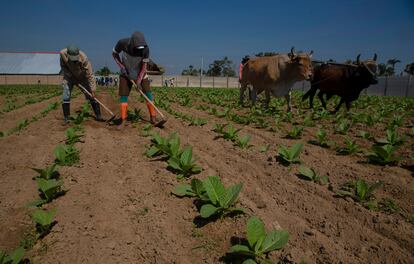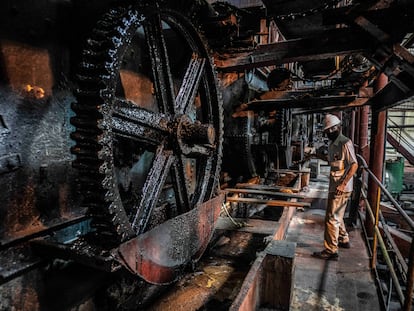Cuba tobacco farmers recuperate after ruinous Hurricane Ian
Hurricane Ian devastated 80% of the region’s tobacco infrastructure, adding to an already intense economic crisis on the island

A neighbor lent him a house to dry leaves, and he had a little fertilizer saved, so he plucked up the courage to plant. Now, Hirochi Robaina can hardly believe the resulting miracle. Robaina, one of the most recognized tobacco producers in Cuba, marvels as he walks through the intense green of plants that have grown more than a meter (three feet) high in the Pinar del Rio region.
Six months after Hurricane Ian devastated 80% of the region’s tobacco infrastructure, farmers are trying to recuperate from the disaster. And though they’ll produce less than in past seasons, they say they’ll still be able to harvest the leaves for premium hand-rolled cigars, one of the Caribbean nation’s key exports.
“Not a single tobacco house was left standing. There were no warehouses, there was no tree left,” Robaino told The Associated Press, remembering how the storm left the region at the end of September. “Everything broke and at that moment I did not believe it was possible to plant.”
Robaina, 46, is heir to a grandfather’s estate that is so famous that a cigar brand bears his name: Vegas Robaina. At the beginning of October, Robaiana was resigned to planting only beans and vegetables – something, at least, but a waste of land that can produce some of the finest export tobacco.
But then he changed his mind and decided to try planting tobacco “to maintain the family tradition of a century,” he said, showing his tobacco over two hectares (about five acres) – or about 30% of what he had at this time in 2022.
Ian’s impact added to an already intense economic crisis in Cuba, where the Gross Domestic Product (GDP) dropped 11% in 2020.
Many farmers don’t remember ever having lived through the kind of destruction brought by the hurricane. In the fall, they had doubted they would even be able to plant any tobacco this season. It requires special care, application of fertilizers at precise moments, irrigation, cloth to cover the plants and drying houses for the leaves.
With winds of more than 200 kilometers per hour (125 miles per hour), Ian crossed the island from south to north to the west, devastating the Pinar del Río region where 80% of the island’s tobacco is produced including almost all of its tobacco for export.
Five people in Cuba died overall and 30,000 were evacuated. Thousands of utility poles fell. Entire communities were without electricity, water, and telephones for weeks. Rice, corn, sweet potato and fruit crops were destroyed.
Some 10,000 tobacco drying houses were toppled. About 33,000 tons of stored leaves were lost, according to authorities.
Private tobacco producers have been meeting with authorities since last fall to secure commitments for the state to help settle debts and pay for materials to rebuild tobacco drying houses. Help also has come from fellow tobacco producing nations Nicaragua and the Dominican Republic, and producers also chipped in to help each other.
Reiniel Rojas, a 33-year-old farmer who has been cultivating premium tobacco for ten years, planted 13 hectares (about 30 acres) around La Coloma thanks to the fact that he was able to finish his drying houses.
“The recovery was quick,” Rojas said.
Rojas got seeds from a colleague to plant. Robaina received four chainsaws from producer friends from other countries and his cousin lent him the drying house, while he loaned some fertile land to two other farmers.
Nature also helped by withholding plagues of caterpillars or fungi, so demand for pesticides was low.
A tobacco house costs a producer around $20,000 at the official exchange rate. A good harvest, with the delicate work of a whole year, can pay a farming family up to $50,000 dollars, farmers told the AP.
The figure is not small for Cuba, where a state salary in the city amounts to about $200 a month at the official rate in the limited official economy, but would be only about $29 in practical terms for most Cubans in the broader, informal economy.
Enrique Blanco, agricultural director of Tabacuba, part of the state-owned Cubatabaco company that regulates and manages tobacco, told the AP that this year’s plan for tobacco planting already is down to about 9,500 hectares (23,000 acres) – down from an initially planned 15,000 (37,000).
There will be some 2,100 hectares (5,200 acres) of premium leaves grown under the cover of fabric, with which the country hopes to cover the coming export demand, Blanco said.
Sign up for our weekly newsletter to get more English-language news coverage from EL PAÍS USA Edition
Tu suscripción se está usando en otro dispositivo
¿Quieres añadir otro usuario a tu suscripción?
Si continúas leyendo en este dispositivo, no se podrá leer en el otro.
FlechaTu suscripción se está usando en otro dispositivo y solo puedes acceder a EL PAÍS desde un dispositivo a la vez.
Si quieres compartir tu cuenta, cambia tu suscripción a la modalidad Premium, así podrás añadir otro usuario. Cada uno accederá con su propia cuenta de email, lo que os permitirá personalizar vuestra experiencia en EL PAÍS.
¿Tienes una suscripción de empresa? Accede aquí para contratar más cuentas.
En el caso de no saber quién está usando tu cuenta, te recomendamos cambiar tu contraseña aquí.
Si decides continuar compartiendo tu cuenta, este mensaje se mostrará en tu dispositivo y en el de la otra persona que está usando tu cuenta de forma indefinida, afectando a tu experiencia de lectura. Puedes consultar aquí los términos y condiciones de la suscripción digital.
More information
Archived In
Últimas noticias
A survivor’s account of the Interoceanic Train accident: ‘We were scared because of the speed on the curve’
The Interoceanic Train, the Mexican alternative to the Panama Canal
What is known about the Interoceanic Train derailment in Oaxaca
Trump turns a Minnesota fraud allegation into ammunition for his MAGA army against Democrats
Most viewed
- Oona Chaplin: ‘I told James Cameron that I was living in a treehouse and starting a permaculture project with a friend’
- Reinhard Genzel, Nobel laureate in physics: ‘One-minute videos will never give you the truth’
- Why the price of coffee has skyrocketed: from Brazilian plantations to specialty coffee houses
- Pablo Escobar’s hippos: A serious environmental problem, 40 years on
- Chevy Chase, the beloved comedian who was a monster off camera: ‘Not everyone hated him, just the people who’ve worked with him’










































